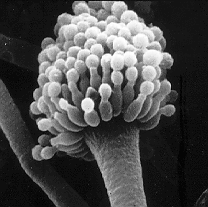Related Research Articles

Helotiales is an order of the class Leotiomycetes within the division Ascomycota. The taxonomy within Helotiales has been debated. It has expanded significantly as genomic techniques for taxonomical identification have become more commonly used. As of February 2020, the order is estimated to contain 30 accepted families, 519 genera, and 6266 species.
Amorphotheca resinae is an ascomycete fungus of the family Amorphothecaceae which is known to thrive in environments containing alkanes, like aviation fuel, from which it derives its trivial name 'kerosene fungus'. As such it belongs to the heterogenous group of microbial contaminants of diesel fuel.
The Diporothecaceae are a family of fungi in the Ascomycota phylum. This family can not yet be taxonomically classified in any of the ascomycetous classes and orders with any degree of certainty. It contains the single genus Diporotheca.
The Eoterfeziaceae are a family of fungi in the Ascomycota phylum. This family can not yet be taxonomically classified in any of the ascomycetous classes and orders with any degree of certainty.
The Hispidicarpomycetaceae are a family of fungi in the Ascomycota phylum. This family can not yet be taxonomically classified in any of the ascomycetous classes and orders with any degree of certainty. It contains the single genus Hispidicarpomyces.

The Pseudeurotiaceae are a family of fungi in the division Ascomycota. This family can not yet be taxonomically classified in any of the ascomycetous classes and orders with any degree of certainty.
The Pleurotremataceae are a family of fungi in the Ascomycota phylum. This family can not yet be taxonomically classified in any of the ascomycetous classes and orders with any degree of certainty.
The Phyllobatheliaceae are a family of fungi in the Ascomycota phylum. This family can not yet be taxonomically classified in any of the ascomycetous classes and orders with any degree of certainty.
The Mucomassariaceae are a family of fungi in the Ascomycota phylum. This family can not yet be taxonomically classified in any of the ascomycetous classes and orders with any degree of certainty. It contains the single genus Mucomassaria
The Lautosporaceae are a family of fungi in the Ascomycota phylum. This family can not yet be taxonomically classified in any of the ascomycetous classes and orders with any degree of certainty. It contains the single genus Lautospora.
Argentinomyces is a genus of fungi in the Ascomycota phylum. The relationship of this taxon to other taxa within the phylum is unknown, and it has not yet been placed with certainty into any class, order, or family. This is a monotypic genus, containing the single species Argentinomyces naviculisporus.
Igneocumulus is a fungal genus in the division Ascomycota. The relationship of this taxon to other taxa within the phylum is unknown, and it has not yet been placed with certainty into any class, order, or family. This is a monotypic genus, containing the single species Igneocumulus yuccae.
Micromastia is a genus of fungi in the Ascomycota phylum. The two known members are Micromastia fimicola and Micromastia trigonospora. The relationship of this taxon to other taxa within the phylum is unknown, and it has not yet been placed with certainty into any class, order, or family.
Ochrosphaera is a genus of fungi in the Ascomycota phylum. The relationship of this taxon to other taxa within the phylum is unknown, and it has not yet been placed with certainty into any class, order, or family. This is a monotypic genus, containing the single species Ochrosphaera meliolae.
Phylloporina is a genus of fungi in the Ascomycota phylum. The relationship of this taxon to other taxa within the phylum is unknown, and it has not yet been placed with certainty into any class, order, or family.
Telioclipeum is a fungal genus in the division Ascomycota. The relationship of this taxon to other taxa within the phylum is unknown, and it has not yet been placed with certainty into any class, order, or family. This is a monotypic genus, containing the single species Telioclipeum lavrense.
Trichoplacia is a fungal genus in the division Ascomycota. The relationship of this taxon to other taxa within the phylum is unknown, and it has not yet been placed with certainty into any class, order, or family. This is a monotypic genus, containing the single species Trichoplacia microscopica.
Xylogone is a genus of fungi in the Ascomycota phylum. The relationship of this taxon to other taxa within the phylum is unknown, and it has not yet been placed with certainty into any class, order, or family. This is a monotypic genus, containing the single species Xylogone sphaerospora.

Eurotiomycetidae is a subclass of the Eurotiomycetes.
References
- ↑ Lumbsch TH, Huhndorf SM. (December 2007). "Outline of Ascomycota – 2007". Myconet. Chicago, USA: The Field Museum, Department of Botany. 13: 1–58. Archived from the original on 2009-03-18.
- ↑ Description by DOE Joint Genome Institute